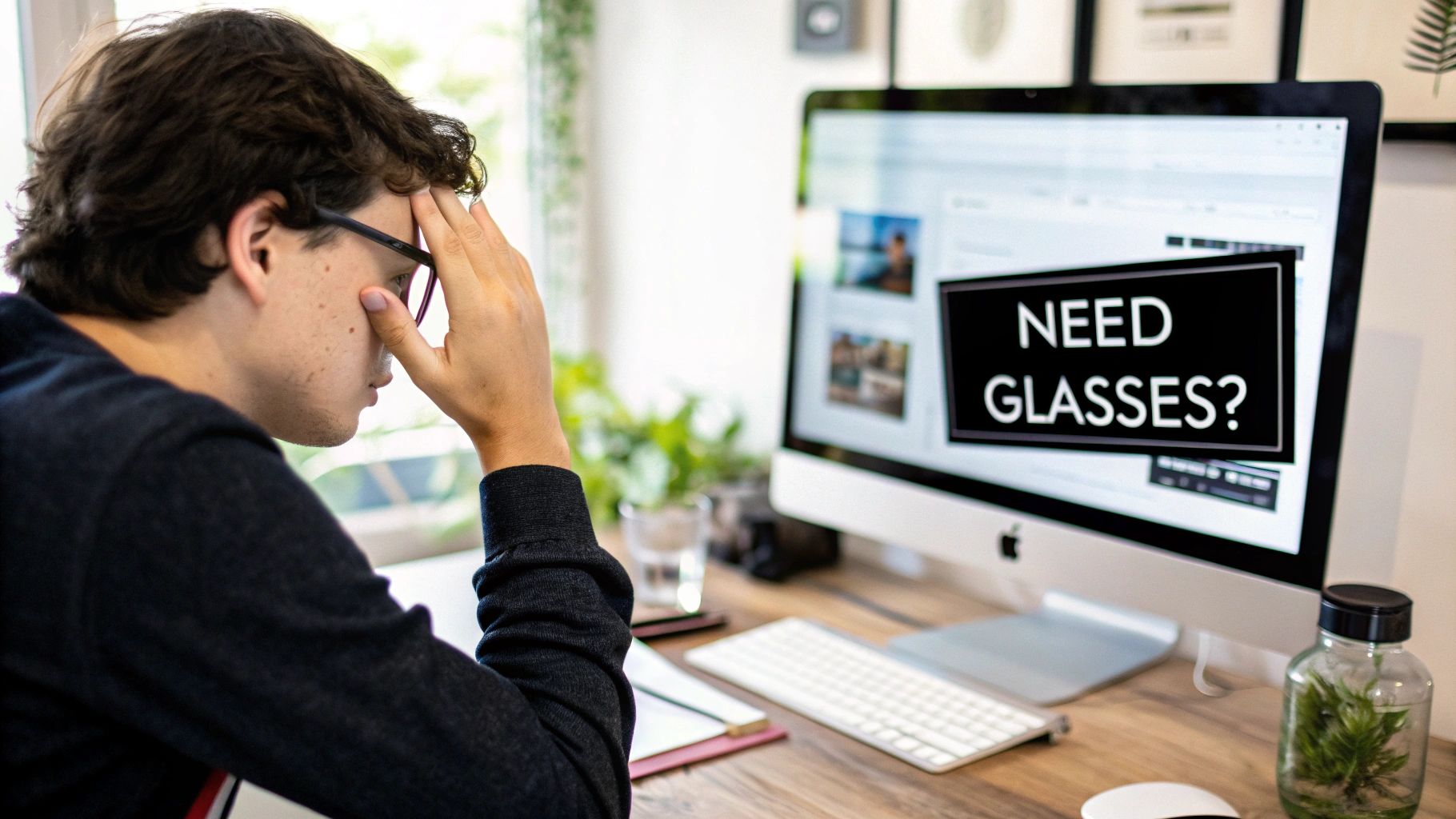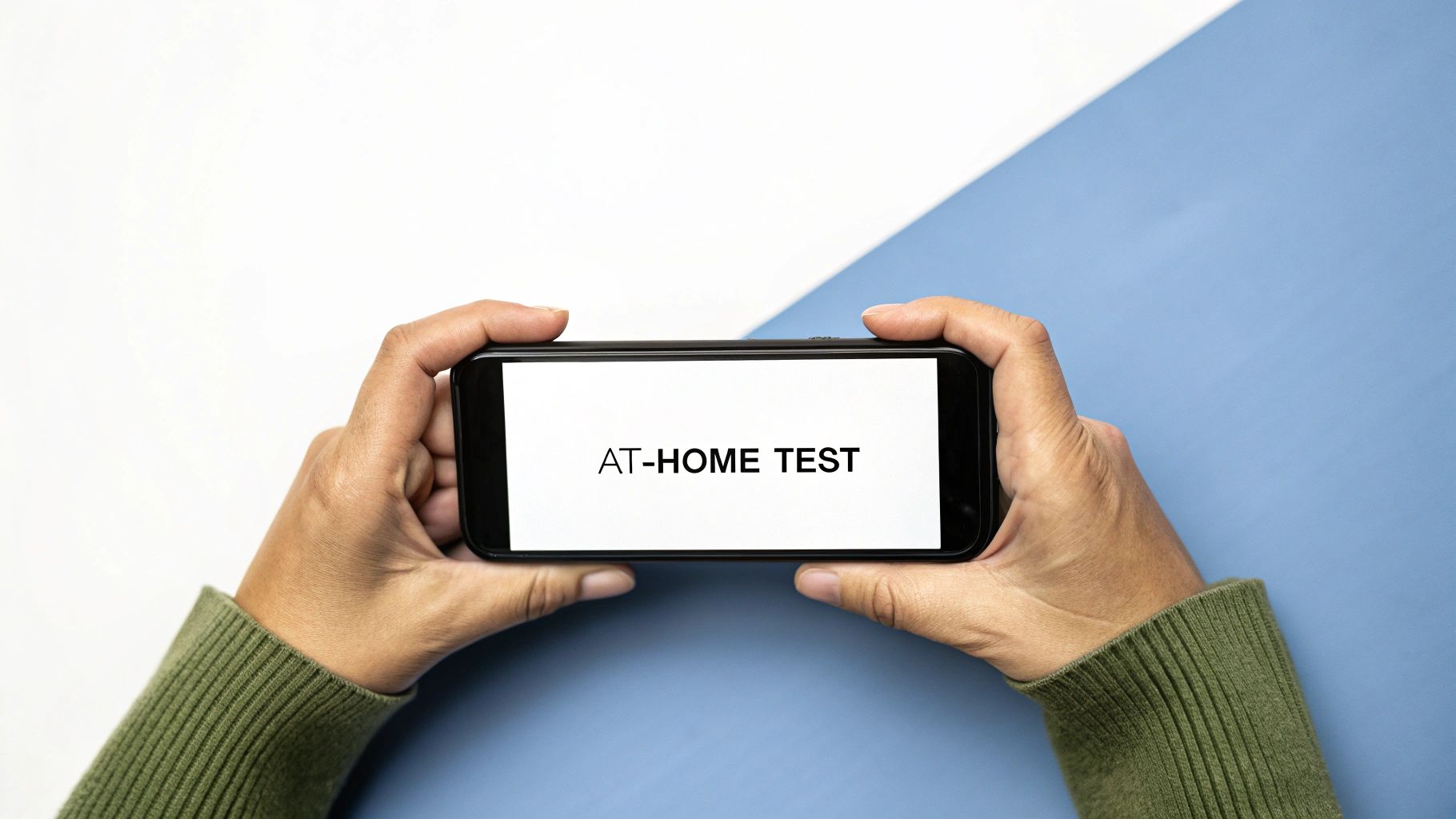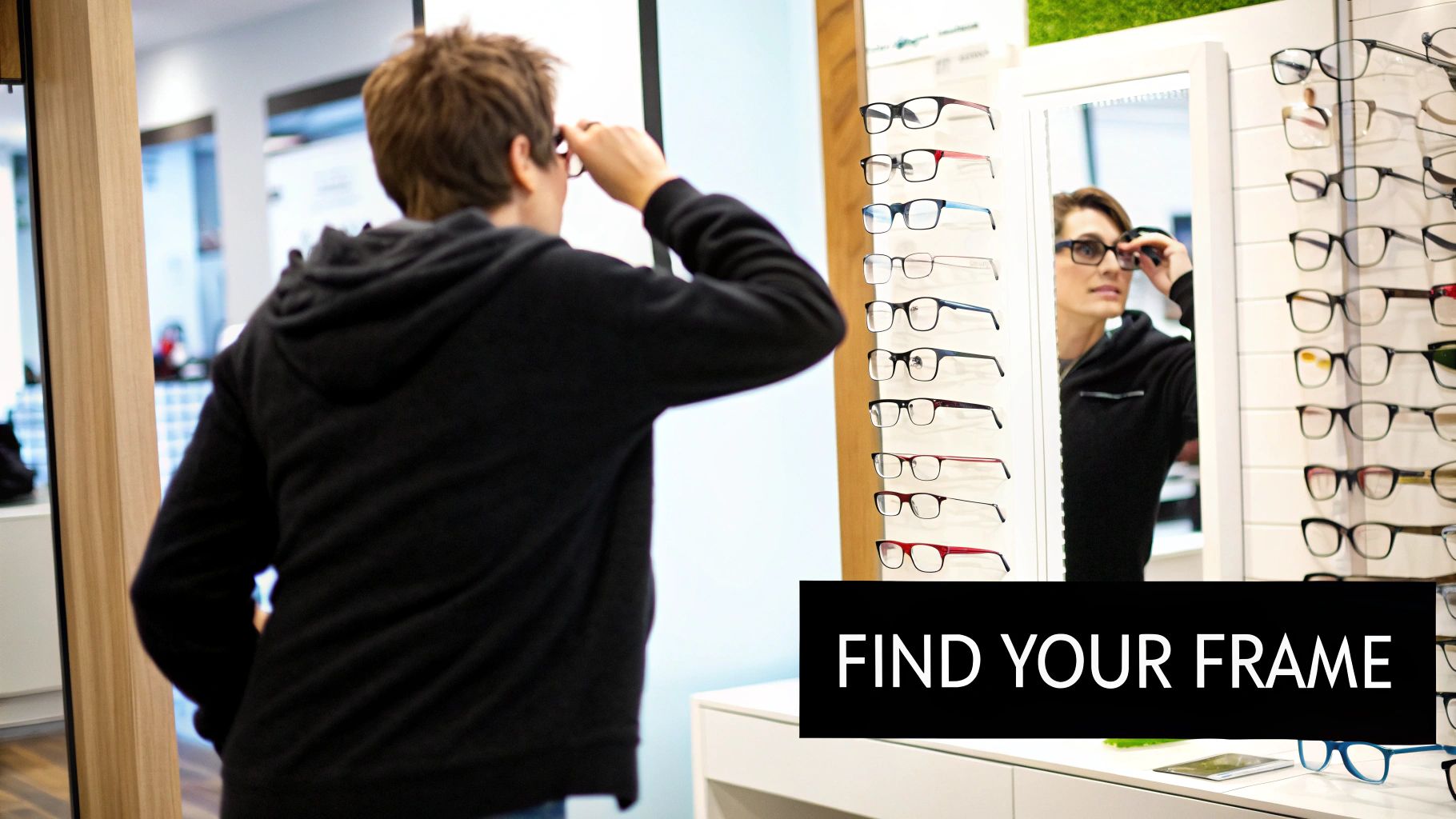So, how do you know if you actually need glasses? The answer isn't always a sudden, dramatic change. More often than not, it’s the small, everyday struggles that are trying to tell you something.
Think about it. Are you squinting to read a text message? Getting those annoying frequent headaches after a day at the computer? Or maybe you've noticed that street signs stay blurry until you’re almost right underneath them. These little frustrations are your eyes' way of sending up a flare, signalling they could use some support. Poor vision isn't just an inconvenience; it can be a safety risk, especially when driving or navigating unfamiliar places.
Are You Missing the Signs Your Eyes Need Help?

It’s incredibly easy to brush off minor vision changes. We blame them on being tired or stressed out. You might find yourself holding your phone at arm's length to read an email, or maybe you get that dull, throbbing ache behind your eyes after a few hours of screen time.
These aren't just random annoyances. They're classic signs that your eyes are working overtime just to focus.
The sneaky thing is, these symptoms often creep up so gradually you don't even notice them until they become a constant problem. A perfect practical example is blaming a headache on a long, tough day at work, when it’s actually your eyes straining to make sense of blurry text on your monitor. Learning to recognise these patterns is the first real step toward better eye health and safety.
Why Paying Attention Matters
Ignoring these signals doesn't just lead to more discomfort—it can seriously impact your daily life, from feeling safe driving at night to simply enjoying a good book. Being proactive is key, especially since our vision naturally changes as we get older. Protecting your vision is a critical part of your overall health.
In Australia, a staggering 13 million people have at least one long-term eye condition. It's particularly widespread among older adults, with chronic vision disorders affecting 93% of those aged 65 and over. That statistic really highlights how common vision impairment becomes later in life. You can dig into more local data on eye health over at Optometry Australia.
Start taking a mental note of when and where you struggle to see clearly. For example, do you only have trouble in dimly lit restaurants, or is it a constant issue? This information is gold. It empowers you to seek professional advice before a small issue snowballs into a major problem, ensuring your vision gets the care it deserves. From there, we can customize an eye wear package to suit your requirements.
Quick Symptom Checker: Do You Need an Eye Test?
Sometimes it's hard to connect the dots between a daily annoyance and an actual vision problem. This quick table can help you see how common experiences might be linked to an underlying need for an eye check-up.
| Symptom You're Experiencing | What It Could Mean | Immediate Action to Consider |
|---|---|---|
| Frequent headaches, especially after screen time | Eye strain from uncorrected refractive errors (like astigmatism or farsightedness) | Take regular breaks using the 20-20-20 rule and book an eye test if they persist. |
| Squinting to see distant objects (e.g., road signs) | Myopia (nearsightedness) | Avoid driving at night if vision is severely compromised, as this is a major safety risk. Schedule a comprehensive eye exam. |
| Holding books or your phone further away to read | Presbyopia (age-related farsightedness, common over 40) | Try over-the-counter reading glasses for temporary relief, but see an optometrist for a proper check. |
| Blurry or double vision | Can range from simple astigmatism to more serious conditions like cataracts. | This warrants immediate attention for your health and safety. Book an appointment with an eye care professional. |
| Seeing halos around lights, particularly at night | Could be a sign of cataracts, astigmatism, or even glaucoma. | Don't ignore this. An optometrist needs to rule out serious conditions that could affect your eye health. |
| Eyes feel tired, sore, or gritty often | Digital eye strain or Dry Eye Syndrome. | Use lubricating eye drops and make sure your workspace is well-lit and ergonomically sound. |
This is just a guide, of course. If you're ticking off any of these boxes regularly, it’s a strong hint that your eyes are asking for help. A professional eye test is the only way to know for sure what's going on and get the right solution to protect your vision.
Decoding Everyday Vision Problems
Vision problems have a sneaky way of creeping up on us. They often start so subtly that we brush them off as just being tired or stressed. But that nagging headache after a day at the computer, or finding yourself squinting at your phone? That isn't just a minor annoyance; it's your eyes trying to tell you something important about their health.
Take blurry vision, for instance. It’s not just one thing. A practical example is noticing that road signs only come into focus when you're right on top of them, creating a potential driving hazard. Or perhaps the words in your favourite book now have a fuzzy halo, forcing you to blink constantly just to clear things up. These are real-world examples of declining sharpness that often point to common refractive errors.
Pinpointing Specific Symptoms
Beyond a general blurriness, other distinct issues can signal it’s time to see a professional. Paying attention to these patterns is the first step toward protecting your eye health and safety.
Are any of these sounding a bit too familiar?
- Persistent Headaches: I’m not talking about just any headache. This is a dull, throbbing pain that tends to settle around your temples or right behind your eyes, especially after reading or screen time. A practical example: the headache always starts around 3 PM after a few hours of staring at spreadsheets. It’s a classic sign that your eye muscles are working overtime to focus.
- Constant Squinting: Do you catch yourself narrowing your eyes to read a menu in a restaurant or make out a friend’s face across the street? Squinting is a temporary trick to improve focus, and if you’re relying on it, your vision definitely needs a bit of support.
- Seeing Halos at Night: When you're driving after dark, do oncoming headlights seem to have a glowing ring or halo around them? This is a significant safety concern and can be a symptom of astigmatism or other conditions that an eye test can easily pick up on.
This simple flow chart shows the most common progression, from struggling with distance vision to dealing with strain and headaches.
As you can see, one unaddressed issue often leads to another, creating a cycle of discomfort that a simple pair of glasses could fix.
When Your Environment Feels Wrong
Sometimes, the clues aren't in what you see, but in what you do to see. You might find yourself constantly bumping up the font size on your phone or cranking up the screen brightness just to get by. This is your brain trying to compensate for an underlying vision problem.
Eye fatigue that kicks in after just twenty minutes of reading or screen time is another major red flag. If your eyes feel tired, achy, or heavy long before the rest of you does, it’s a clear indication they are under serious strain.
If these scenarios are hitting close to home, it's time to stop adapting to poor vision and start looking for a solution. Once we have a clear picture of your prescription, we can customize an eye wear package to suit your requirements, ensuring you see the world with the comfort and clarity you deserve.
Simple Vision Checks You Can Do at Home

While nothing can replace a comprehensive exam with your optometrist, you can run a few simple checks at home to get a better handle on your eyesight. Think of these as a personal fact-finding mission, not a diagnosis. They're a great way to arm yourself with useful information before your next appointment and take an active role in your eye health.
A practical example is the reading distance test. Grab your phone and hold it where you’d normally read. Find yourself slowly pushing it further away to get the words in focus? That’s often the first sign of presbyopia, the age-related change that makes close-up vision tricky.
Next, try the distance clarity test. Look out your window at a street sign you know you should be able to read clearly. Cover one eye, read it, then switch. If the letters seem blurry or fuzzy with either eye, it could be a hint of myopia (nearsightedness). This is an important safety check, especially if you drive.
What About Your Digital Vision?
With so much of our lives spent staring at screens, it’s smart to check for digital eye strain. After you’ve been on the computer for about 20-30 minutes, glance away at something far across the room. Do your eyes feel achy or take a moment to refocus? That nagging discomfort is a big clue your eyes are being overworked.
It's so important to pay attention to these little signs. Vision impairment is a significant issue in Australia, with over 575,000 people estimated to be blind or have low vision. A huge portion of these cases stem from uncorrected refractive errors—something that glasses can usually fix. You can read more about vision health statistics in Australia to understand the full picture.
Remember, these home checks are all about spotting patterns. A single blurry moment might just be a fluke, but if you're consistently noticing these issues, it’s a clear signal to book an exam. Make a few notes on what you find so you can discuss it with an expert.
Once you have a prescription, the right fit is everything. We’ve actually got a handy guide on how to measure pupillary distance at home, which is a key measurement for getting glasses online. After you’ve seen a professional, we can customize an eye wear package to suit your requirements, ensuring you get the best possible clarity and comfort.
When It Is Time to See an Optometrist
While at-home checks are a great starting point, they can't replace the trained eye of a professional. Some symptoms aren't just minor annoyances; they're red flags that need an optometrist’s attention to protect your vision and overall eye health.
Things like sudden blurry vision or a new shadow creeping into your view shouldn't be ignored. The same goes for seeing flashes of light or a sudden storm of "floaters". These can be signs of a detached retina, which requires immediate medical attention to prevent permanent vision loss. If any of these happen, it’s time to book an eye exam, and fast.
Urgent vs Important Triggers for an Exam
Not every sign means you need to rush to the clinic, but many are clear signals that a check-up is overdue. Knowing the difference helps you make the right call for your eye health and safety.
Here are some less urgent, but just as important, reasons to schedule an appointment:
- Your Home Checks Point to a Problem: If those at-home tests consistently show you’re struggling to see clearly, whether it’s up close or far away, that’s your cue to get a professional opinion.
- It Has Been Too Long: Eye health experts generally recommend adults get a comprehensive eye test every one to two years. That’s even if you haven’t noticed any problems at all.
- You Have Specific Health Risks: Conditions like diabetes or high blood pressure can have a huge impact on your eyes. A family history of eye diseases, like glaucoma or macular degeneration, also puts you in a higher-risk category.
What to Expect During a Comprehensive Eye Exam
A trip to the optometrist is about so much more than just figuring out if you need glasses. Think of it as a crucial check-up for your overall eye health and safety.
An optometrist will test how sharp your vision is, but they’ll also look for early signs of common eye diseases, check how well your eyes work together, and measure your eye pressure. To get a better idea of what's involved, you can learn more about a typical eye check-up to feel more prepared.
Visiting an optometrist regularly isn't just about fixing problems—it's about preventing them. Many serious eye conditions don't have obvious symptoms in the early stages, making routine exams your best line of defence for long-term vision health.
This kind of preventative care is especially vital for at-risk communities. For instance, vision impairment and blindness occur among Indigenous Australians at three times the rate of other Australians. It’s a critical issue, particularly when you realise around 90% of all severe vision impairment in Australia is preventable or treatable if caught early. You can find more insights on these eye health disparities on health.gov.au.
Once a professional has given you a clear picture of your vision needs, we can customize an eye wear package to suit your requirements, making sure you get the exact correction and comfort you need.
Choosing the Right Eyewear for Your Life

Finding out you need glasses is the first hurdle. The fun part comes next: picking the perfect pair. This shouldn't feel like a chore; think of it as a chance to level up your vision, personal style, and even your daily safety.
It all starts with your prescription. You'll see terms like myopia (nearsightedness), hyperopia (farsightedness), or astigmatism. These just describe how your eyes focus light. For instance, if you’re nearsighted, distant objects look blurry, but anything up close is sharp and clear.
Matching Frames and Lenses to Your Lifestyle
The best glasses are the ones that fit seamlessly into your day-to-day life. Someone working in an office has completely different needs from an outdoor adventurer, and your eyewear should reflect that.
Let’s look at a few practical examples:
- The Digital Professional: If you're staring at screens all day, lenses with a blue light filter are a game-changer. They can seriously reduce that feeling of digital eye strain and make your workday more comfortable.
- The Outdoor Enthusiast: For anyone who loves the outdoors, polarised sunglasses are essential for cutting down glare when you're driving or fishing. Photochromic lenses, which darken automatically in the sun, are another fantastic option for protecting your eyes from harmful UV rays.
- The Night Driver: An anti-glare coating on your lenses can make a massive difference. It helps reduce those distracting halos and starbursts from oncoming headlights, making your drive safer and much less stressful.
Of course, finding frames that make you feel great is just as important. Your face shape has a lot to do with which styles will flatter you the most. For some personalised tips, have a look at our guide on what glasses suit my face.
Choosing eyewear is a personal journey. It’s all about finding that sweet spot where function, comfort, and fashion meet to create something that not only corrects your vision but genuinely enhances your life.
Your vision needs are as unique as you are, which is why a one-size-fits-all approach just doesn’t cut it. By focusing on your specific lifestyle and prescription, you can land on the perfect solution. Remember, we can customize an eye wear package to suit your requirements, ensuring you get the ideal blend of frames and lenses.
Got Questions About Needing Glasses?
It’s completely normal to have questions pop up when you first suspect you might need glasses. Getting clear answers is the best way to feel confident about taking care of your eyesight and making safe choices. Let’s tackle some of the most common worries and queries with some straight-up, practical advice.
One of the biggest myths I hear all the time is that wearing glasses will make your eyes weaker. Let's put that one to rest: it’s simply not true.
Think of it this way: your glasses don’t change your eyes. They just bend light correctly so it hits the right spot on your retina, giving you that crisp, clear vision you’ve been missing. They’re a tool to help your eyes perform at their absolute best and see the world safely, not a crutch that causes dependency.
Navigating Eye Care and Finding the Right Specs
Getting your head around the basics of eye care and the different types of glasses out there is a game-changer. It helps you make smart decisions for your vision health.
A question that comes up frequently is how often you should get your eyes checked. For most adults under 40 with no known vision problems or risk factors, an eye exam every two years is a solid guideline. But if you’re over 40, or if you have a condition like diabetes, booking in for a yearly check-up is crucial for proactive eye health management.
Another point of confusion is the difference between the readers you can grab off the shelf at the chemist and a pair of custom prescription glasses.
Off-the-shelf reading glasses offer a simple, one-size-fits-all magnification. They’re a handy fix for age-related farsightedness (presbyopia). Custom prescription glasses, on the other hand, are tailored specifically to you, correcting unique issues like astigmatism or different levels of vision in each eye.
So, if you’re finding it hard to read a menu and you’re squinting to see road signs, a generic pair of readers just won’t cut it. That's a job for a custom prescription that addresses all your visual needs, ensuring you see clearly and comfortably at all distances.
At Prescript Glasses, we know that no two pairs of eyes are the same. Once you have your prescription from your optometrist, we can customize an eye wear package to suit your requirements—from advanced lens coatings to frames that match your lifestyle. Explore our options and see the difference for yourself.

